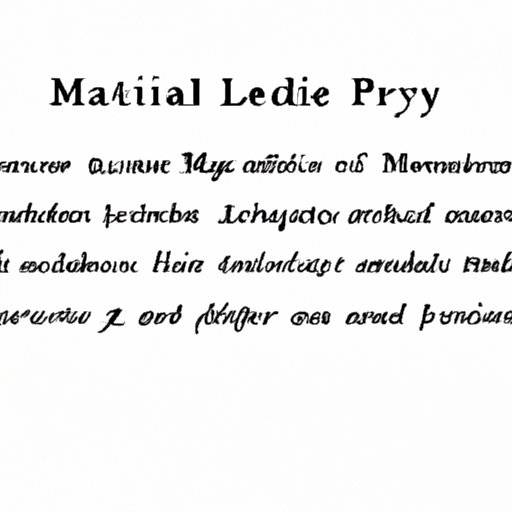
I. Introduction
If you’re a student or academic, you’re likely familiar with the MLA (Modern Language Association) format for citing sources in academic writing. While it’s important to cite any sources you use, many students may be unsure of how to properly cite poems in MLA format. This article will provide a beginner’s guide to citing poems in MLA format, with a step-by-step guide, tips and tricks, and examples.
II. Understanding the Rules and Guidelines
Before we dive into the specifics of citing poems in MLA format, let’s start with some basic rules. When citing a poem in MLA format, you will need to follow a specific set of guidelines for formatting and including citation information. Here’s a step-by-step guide:
– Begin with the poet’s last name, followed by a comma and their first name. For example, if you were citing a poem by Maya Angelou, the citation would begin: Angelou, Maya.
– Next, include the title of the poem in quotation marks. For example, “Still I Rise.”
– Then, include the title of the collection the poem appears in, also in italics. For example, The Complete Collected Poems of Maya Angelou.
– Next, include the editor of the collection (if applicable) followed by the publication information, including the publisher, year, and page numbers. For example, edited by Robert Loomis, Random House, 1994, pp. 212-213.
III. The Importance of Citing Poems in Academic Writing
It’s important to cite any sources you use in academic writing, including poems, for several reasons. First and foremost, citing sources helps to give credit to the original author and acknowledge their work. It also allows readers to easily locate and verify the sources you use. Additionally, failing to properly cite sources can result in accusations of plagiarism, which can have serious consequences for academic and professional careers.
IV. MLA Style Guide for Citing Poems
The MLA Handbook provides guidelines for citing poems in both print and online formats. Here are some tips and tricks for beginners:
– When citing a poem in print, use the standard citation format outlined above.
– When citing a poem from an online source, include the author’s name (if known), the title of the poem in quotation marks, the title of the website, the editor or sponsor of the website (if applicable), the date of publication (if known), and the URL. For example: Angelou, Maya. “Still I Rise.” Poetry Foundation, Poetry Foundation, 2005, www.poetryfoundation.org/poems/46446/still-i-rise.
– Be sure to italicize the title of the collection the poem appears in and the title of the website (if applicable).
– If you’re citing a poem from an anthology, include the editor’s name and the title of the anthology in italics.
V. Quoting Poetry in MLA Format: The Do’s and Don’ts
When incorporating poetry into your text, it’s important to follow certain guidelines to ensure that your use of the poem is clear and properly cited. Here are some important do’s and don’ts to keep in mind:
Do:
– Begin your quotation on a new line.
– Use short lines of verse within the body of your text, with a slash mark (/) to indicate line breaks.
– Use a colon to introduce your quotation in most cases.
– Include line numbers for the poem in parentheses after the quotation.
– Create a works cited page at the end of your paper.
Don’t:
– Introduce your quotation with a comma or conjunction.
– Change the capitalization of the first word in a line of poetry.
– Use quotation marks to indicate line breaks.
– Include the entire poem in your paper.
VI. Understanding MLA Citation Guidelines for Poems: Everything You Need to Know
Now that we’ve covered some basic guidelines for citing and incorporating poetry into your text, let’s delve a little deeper into MLA citation guidelines for poems. Here are some additional things to keep in mind:
– If the poem you’re citing spans multiple pages, use “pp.” to indicate the range of pages.
– If the poem you’re citing does not have line numbers, use “n. pag.” to indicate that the line numbers are not known.
– If you’re citing a long poem, use ellipses to indicate omitted lines.
– If you’re citing a translated poem, include the name of the translator after the title of the poem.
VII. MLA Citation for Poems: Examples and Explanations
To help illustrate the guidelines we’ve discussed, here are some examples of correctly formatted MLA citations for various types of poems:
– Single poem from a collection: Angelou, Maya. “Still I Rise.” The Complete Collected Poems of Maya Angelou, edited by Robert Loomis, Random House, 1994, pp. 212-213.
– Poem from an online source: Angelou, Maya. “Still I Rise.” Poetry Foundation, Poetry Foundation, 2005, www.poetryfoundation.org/poems/46446/still-i-rise.
– Poem from an anthology: Frost, Robert. “The Road Not Taken.” Literature: An Introduction to Fiction, Poetry, and Drama, edited by X.J. Kennedy and Dana Gioia, 11th ed., Pearson, 2010, pp. 807-808.
VIII. A Beginner’s Guide to Citing Poems in MLA Format: Simple Tips for Easy Referencing
To recap the most important information covered in this article, here are some simple tips for beginners to keep in mind:
– Begin with the poet’s last name, followed by their first name.
– Use quotation marks around the title of the poem and italics for the title of the collection or website.
– Include editor or sponsor information (if applicable) and publication information.
– Use short lines of verse within your text and include line numbers.
– Create a works cited page at the end of your paper.
IX. Conclusion
Citing sources in MLA format, including poems, is an important part of academic writing. By following the guidelines outlined in this article, you can properly and easily reference poems in your work. Remember to always give credit to the original author and avoid the consequences of plagiarism. Challenge yourself to put what you’ve learned into practice and see the difference it can make in your writing.





